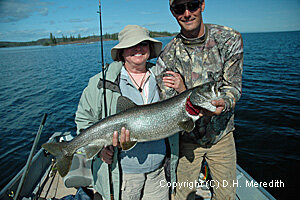Great Slave Lakers
by Don H. Meredith © 2010
(first published in the April 2010 Alberta Outdoorsmen)
One of the icons of outdoor adventures in Canada is the northern fishing lodge. I can remember as a youth reading about such lodges, seeing the pictures of unbelievable fish and scenery, and wondering if I would ever get the chance to experience it. Of course, life often gets in the way of young people’s dreams; and although I spent many seasons in the North as a wildlife biologist, work did not permit me to fully partake in the fishing opportunities. That’s why my wife Betty and I jumped at the chance to go to one of Canada’s premier lodges last summer along with our friends, Adrienne and Duane Radford.
Plummer’s Great Slave Lake Lodge is one of the oldest lodges in the North. Great Slave Lake itself is the ninth largest lake in the world (28,500 sq. km; 11,000 sq. mi.), and the deepest in North America (614 m; 2014 ft.). It is ice free maybe four months of the year and the water is cold at all times. Under such conditions, fish grow slowly; and under low fishing pressure, they grow very large over a long life.
Yellowknife, the capital of the Northwest Territories, is located on the northwest shore of Great Slave Lake. It developed in the 1930s as a result of gold mining in the area. In 1938 those mines attracted businessman C.C. Plummer and his son Warren from Manitoba. The Plummers were avid outdoorsmen and soon heard stories about incredible fishing at Taltheilei Narrows on the east arm of the lake. They hired Dog-Rib chief, Joseph Abell, to guide them the 240 km to the narrows via a canoe powered by a four-horsepower outboard motor. Upon arrival at the narrows, they confirmed the truth of the stories: trophy lake trout could be caught in abundance at Taltheilei Narrows.
For several years thereafter, bush pilot Warren Plummer ferried anglers from Ontario to the narrows via his Beaver (2000 km trip). Soon, he built a cabin and in 1953 hired staff to provide amenities and guiding services. The camp quickly grew as news spread in fishing circles about what was available; and Plummer opened other lodges on Great Bear Lake and elsewhere. The Beaver was replaced by larger aircraft bringing anglers from Ontario and later Manitoba. Today, anglers take scheduled commercial flights to Yellowknife where a chartered plane takes them to the lodges. This was the route we took last August, flying from Edmonton to Yellowknife one day and onto the lodge early the next morning. Upon arrival we were provided a hearty breakfast, shown our rooms, introduced to our guides and were soon on the water.
Fishing in Canada’s north can be a risky business. Weather can change on a dime, and one must be prepared for all possibilities. Good rain gear is a must, as is warm, layered clothing. As well, good boats and motors are essential. The lodge provides 18 foot aluminum boats with 30-horsepower outboards. But perhaps the most important asset they provide is experienced and knowledgeable guides.
Betty and I drew guide Sean Root, who has several years experience at the lodge and many more in the North. While Betty and I fished with traditional hardware, Duane and Adrienne were interested in catching lake trout on fly fishing gear. They drew guide Garret Braun. Although we travelled the lake together, Garret took the Radfords to waters where lake trout were more likely to strike a proffered streamer.
Unlike lake trout found in smaller lakes in Alberta, Great Slave lake trout remain relatively close to the surface all summer long. We caught fish on large spoons and flatfish trolled without using additional weight or gear to get them deep.
Although trophy lake trout (20 lb. plus) are the main target species at the lodge, prize northern pike and grayling can also be fished, as well as walleye. However, Sean informed us that the best northern pike fishing occurs when the ice first comes off the lake in July. After that the pike disappear and cannot be found even in the deeper water off the bays as is common in Alberta. He believes they move into the main body of the lake, but no one really knows.
“Hug-and-release” of all trophy fish is the rule at the lodge. Like many northern lodges, Plummer’s realizes their business depends on a good supply of quality trophy fish that take decades to grow. Returning those fish unharmed to be caught again only makes good sense. The guides were expert at helping land large fish and ensuring they were weighed and photographed without harm. That said, we did keep smaller trout (< 10 lb.) for shore lunches.
That first day, Sean and Garret took us south of the narrows into the Hearne Channel. The weather did deteriorate and we were soon glad we had warm clothing and good rain gear. We caught a few trout in the five to eight pound class.
The shore lunches prepared by the guides are one of the specialities of the lodge. Each guide has favorite places to land boats and put on the feast, cooked over an open fire. If you thought there were only a few ways to prepare fish, you haven’t experienced what these fellows provide—truly gourmet feasts that are a highlight of the day.
The following day dawned clear and warm and we fished along the steep banks of the Pethei Peninsula and the islands that define the Hearne Channel. Again, we caught nice size trout along this route. However before we left for the channel, I caught my largest lake trout (23.5 lb.) just off shore from the lodge in the narrows. Indeed, most of the large trout taken at the lodge are taken in or adjacent to Taltheilei Narrows.
The eastern arm of Great Slave Lake is quite different from the main body of the lake. There are numerous islands and peninsulas that offer shelter from the wind and many bays and inlets for a variety of fishing opportunities. Taltheilei Narrows (“place of open water”) is situated between the mainland and Pethei Peninsula and connects Hearne Channel to McLeod Bay. Because of the large size of the lake, water flows through the relatively shallow narrows, first one direction and then the other. According to Sean, the direction has a lot to do with the snow melt during the day, freezing at night and the direction the wind is driving the water. The trout come to the narrows to feed on smaller fish following the current and crowding together in the constricted water.
The next day, we explored the waters of the impressive McLeod Bay. It was an unusually calm day and the barren landscapes reminded me of the art of the Group of Seven painters, desolate and beautiful. Although we didn’t fish for them, we saw remarkable arctic grayling in the impossibly clear water; and caught several trout in the eight to 12 pound range.
On our final day, the rain and wind kept us closer to the lodge, fishing around some of the nearby islands. I caught a second trophy trout at the narrows. This one weighed 22 pounds and gave the best fight, sounding several times and testing the capabilities of rod, reel and angler. It was an impressive demonstration of the strength of these remarkable fish.
While we were there, other anglers at the lodge caught fish in the 30 to 40 pound class. Fish as large as 60 pounds have been caught over the years.
Fishing trophy lake trout in the waters around Taltheilei Narrows was indeed an adventure of a lifetime I won’t soon forget. For more information about Plummer’s Arctic Lodges, check out their website: www.plummerslodges.com







